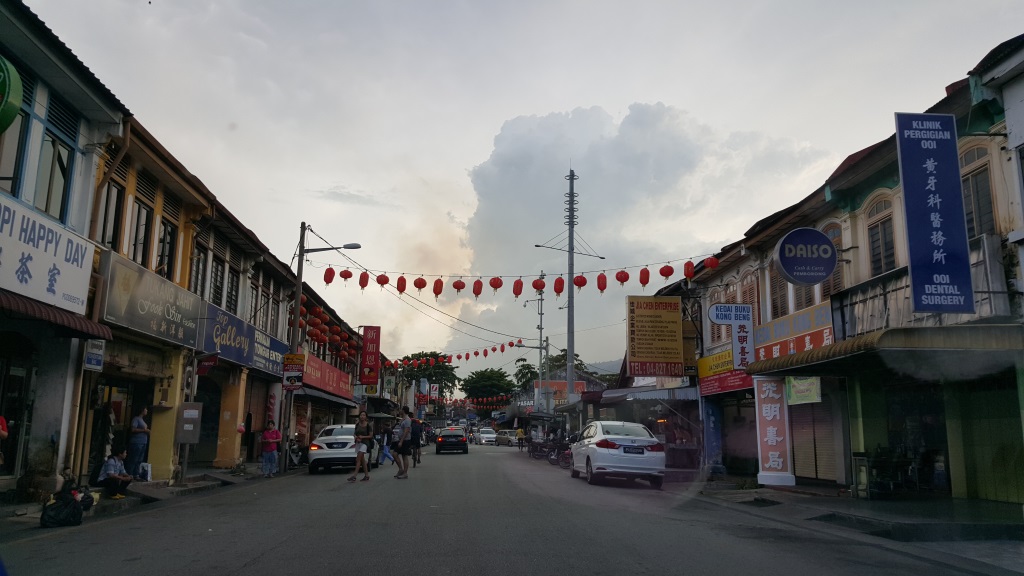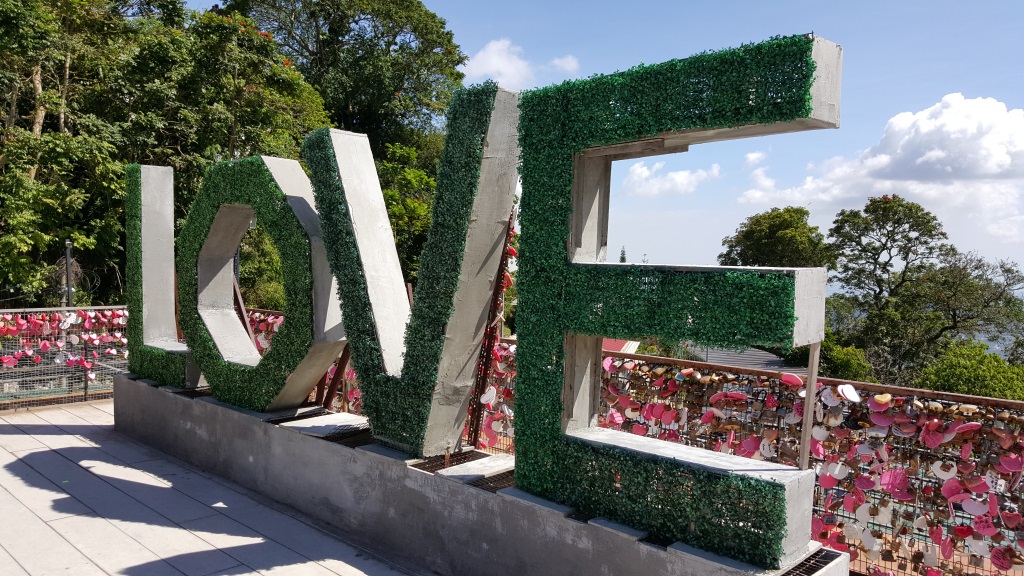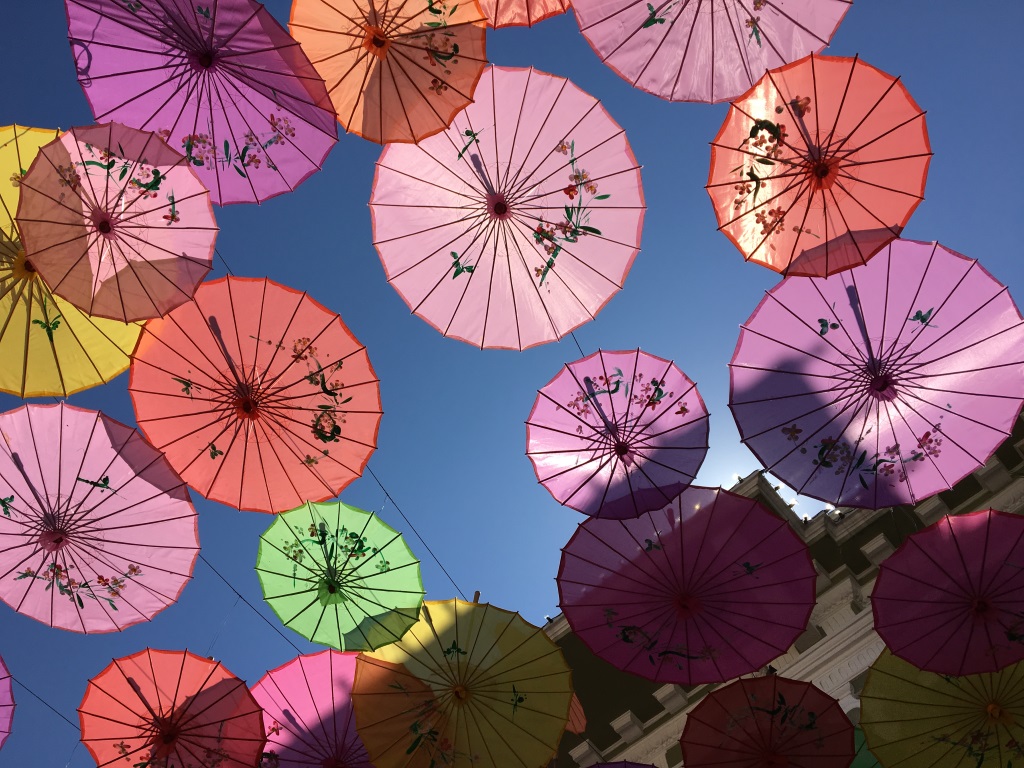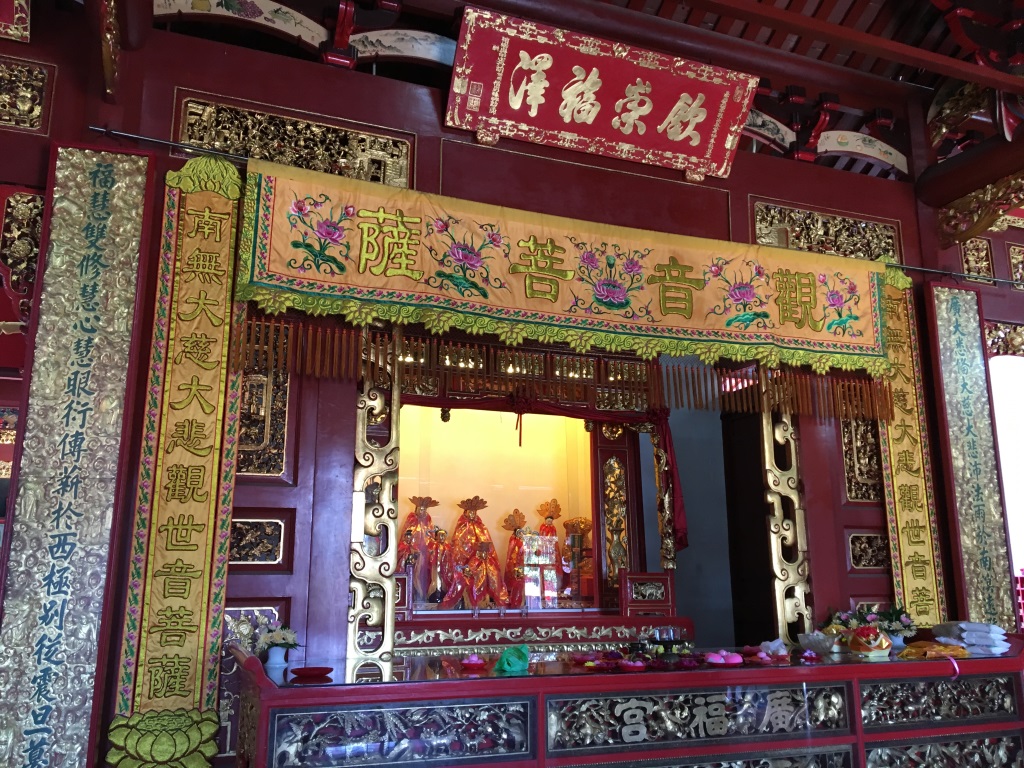
January 5 – February 2, 2016 (Height of dry season)
Greeting: Hello
Gratitude: Thanks
Currency: Ringgit (RM)
Visa: 3 months
Cost of living: Low
The island of Penang sits in the Strait of Malacca west of Peninsular Malaysia, surrounded on all sides by water (as islands so often are). Only 600 km from the Equator, the climate is best classified as “sauna.” Because of its favorable location and history as a shipping and cultural crossroads, Penang’s population density and diversity rival the nation’s capital of Kuala Lumpur. George Town is the island’s capital and largest city, but the entire land mass is classified as an “island city” as the urban areas blend together into a roughly uninterrupted sprawl along the entire eastern shore.
All that diversity and cultural exchange has earned Penang a reputation as the food capital of Malaysia. Malay, Chinese, Indian, Thai, and more are available in infinite combinations and permutations. We’ve seen it deservedly featured on shows like No Reservations↗. For us, the combination of a cheap flight, a new country, and all that tantalizing food made it an easy choice for our second stop in Southeast Asia.
Where we stayed

As with our other stays before and since, we found our lodging on Airbnb. Locking down a good place for a month-long stay can be tricky, since anyone snatching even a single night can throw a wrench into our plan. We now find ourselves booking further and further out to secure the best possible accommodations, but early on in our journey we booked only a couple of months in advance, which left us with limited options in Thailand and Malaysia. For our stay in Penang, we passed on the picked-over listings in George Town and opted instead for a condo in Gelugor. Less a town and more of a named sector of the urban sprawl that envelops the eastern rim of the island, Gelugor was easily a 20 minute drive (on a good day, without traffic, which there always was) from the action in George Town. There area was supposedly serviced by buses, but even the stops were a 20 minute walk away, and the rides would have been 2-3 hours each, so we ended up leaning pretty heavily on Uber↗. There was a lot more supply than demand, so rates were low and it was always easy to find a ride. Our drivers were also incredible. Every one was curious about our stay, excited to chat about food and tourist attractions, and open about their own life experiences.
Driving into town now and then to hit the tourist sights was fine, but the local neighborhood was nothing to write home about. Mostly residential buildings for commuters, there was little to do and walking was challenging and at times treacherous✨. The nearest supermarket was a half-hour walk, with many stretches near fast-moving traffic and without sidewalks or crosswalks. The sweltering heat made our usual shtick of walking everywhere pretty awful.
It’s not uncommon (especially in the tropics where some people may abuse the A/C) for hosts to charge extra for electricity, and our apartment in Malaysia was no exception. We figured we could get used to the heat and get by without air con as we did in Thailand, but we were fools. This heat and humidity was a whole other level. We ended up running the air basically every night just to be able to fall asleep, but this was surprisingly affordable since we were only cooling one room and at non-peak times. Meanwhile we would sweat the days away, which frankly made midday unproductive and unfun. Often we would brave the heat and humidity to walk to the nearby (relatively speaking) Queensbay Mall purely for the free air conditioning. The best time to be out and about was in the evening, when the temperatures fell from “sweat lodge” to just “really, really hot.” It became an daily ritual for us to savor the evening air and head down to the neighborhood hawker stalls for dinner. Between the inconvenience of grocery shopping and the low cost (and excellent quality) of eating out, Penang is up there with Chiang Mai in terms of how little we cooked for ourselves.

As for our apartment, it was basically pretty nice✨. We were in the corner unit on floor eleven of twelve, which gave us a sweeping view of the water, Penang Bridge, and the small forested island of Pulau Jerejak. We had three bedrooms✨, but there wasn’t really anything we could use about the other two (no desk space to make for a workable office or anything), so they simply sat unused✨. The kitchen was decently equipped, and we especially appreciated the gas stove top for the times we put our Thai cooking class recipes to the test. But my god, the ants.
Unfortunately, our host didn’t exhibit much Airbnb spirit. They were more of a condo/hotel that treated Airbnb as another channel for procuring clients. The listing had a number of lies and fabrications. The complimentary airport transfer? We had to pay for it. Breakfast included? Only a couple of vouchers to cover our entire stay (though the one time we redeemed them the food was so astonishingly bad, I don’t consider this a loss). Worse still, on check-in they sprung on us an exorbitant “security deposit” of 1000 RM (almost $250). It was supposed to be refunded on check-out, but in reality it took weeks of us arguing and threatening before we got our money back. This soured our whole experience and, it should be noted, is strictly against Airbnb policy.
What we did

Our neighborhood in Gelugor was fairly boring. Aside from work, we spent most of our time trying to stay cool in our building’s swimming pool✨ or by playing pool or table tennis in the lobby. The relatively close Queensbay Mall✨ was impressively modern and frequently provided us a valued refuge from the worst of the midday heat. Even the food court was superb, and easily put Western options to shame. Our favorite nearby spot, though, was the Telok Bayan hawker stall✨ complex, just a few minutes from our apartment. As food is by far Penang’s strongest selling point, it makes sense that the most enjoyable moments in our stay were in deciding on, savoring, and sharing our incredible meals here.

As often as we could, we’d hail a ride and head up to George Town, the cultural (and in all other ways) capital. Fort Cornwallis✨ is fun to explore, though there isn’t much in the way of education provided. Much more interesting is the adjacent food court, home to Hameed Pata Mee Sotong – recommended to us as one of the absolute best places to eat on the island. The diversity of people in the city comes with a diversity of faiths, so downtown is packed with fascinating and beautiful mosques✨, temples✨, and churches… sometimes sharing the same block! The juxtaposition of colonial architecture and modern✨ development, along with a smattering of great street art✨ murals that could be hiding on any street, made for excellent wandering. We were especially amazed by the Clan Jetties, six piers on the downtown waterfront rimmed by stilt houses, each associated with a specific Chinese clan. Nowadays, tourists wander up and down the narrow walkways✨ while locals sell drinks or ice cream✨ out of their homes to combat the heat.

Near the jetties is the ferry terminal, just the place to catch a Ferry to Butterworth. The corresponding terminal on the other side✨ is far from anything interesting; we mostly just enjoyed the journey. It was a very different experience than the ferries in Washington. Passengers flood right on✨ to the deck, mingling between the automobiles. The center of the deck is reserved for people with some fixed seating, but the sides of the vessel are also lined with fold-out chairs, which we took advantage of for the best views. We enjoyed the opportunity to see Penang from a new angle and to get a closer look at the container ships that make the Strait of Malacca one of the busiest shipping lanes in the world. Besides, the breeze on the open sea was the closest we got to natural cool air our entire stay.

Just on the western edge of the city is the Botanical Gardens. A beautiful and free public park, the gardens host a number of native plants✨ in an accessible setting. It is also the best place to see macaques✨, which wander up and down the paths, clamber around in the trees, and show off for the cameras. We especially enjoyed watching the juveniles attempting to mimic the acrobatics of the older monkeys and not quite getting the hang of it►.

Further still inland is Penang Hill, the highest point in the city. Used in the colonial era as a retreat from the heat and humidity at sea level, the hill is now a major tourist attraction. An incredibly steep and long funicular✨ climbs almost 700 meters in as little as five minutes. The top of the hill hosts restaurants and shops, a mosque✨, and a temple. More importantly, it boasts sweeping views✨ of the island. On the other hand, the area around the funicular station is swarming with macaques, which tend to be hungrier and pushier✨ than their botanical garden brethren. Watching them shred soda cans with their claws for the last drops of sugary liquid inside inspired a newfound respect for the innocent-looking monkeys.

Just under the hill, but still well above the island lowlands, is Kek Lok Si temple, perhaps the biggest and most impressive religious complex on the island. Said to be the largest Buddhist temple in Malaysia, the site features a seven-story-tall pagoda built in three styles (Chinese at the base, Thai in the middle, and Burmese at the top) and covered with ten thousand statues. A short funicular ride► uphill from the main grounds is the other main draw, a 30 meter bronze statue✨ of Guanyin, the Goddess of Mercy. We loved exploring the temple✨ and watching the storm clouds roll over the hills to soak the city below from our solemn vantage point.
We don’t usually do cheesy tourist trap stuff, but we gave the 3D Trick Art Museum in George Town a shot and actually had a pretty good time. The site has dozens of forced-perspective murals and props that you’re supposed to pose in. Some of the resulting photos were amusing✨, but the real fun was in taking them. Similarly, we got our first crack at an escape room puzzle at Mission-Q✨ in Queensbay Mall. We didn’t know what to expect going in, but the two of us make a great team and we beat it with time to spare!

Finally, continuing our streak of lucking into festivals, we happened to be in town for Thaipusam, a Hindu festival that brought thousands to the streets to celebrate with elaborate costumes and piercings✨, (very loud) music, treks to the lofty Balathandayuthapani and Nattukkottai Chettiar✨ temples for prayer, and employers and families alike sharing free food and drink. We were warmly welcomed into a community center✨ and given plates of incredible vegetarian foods that (after only a moment of looking around in confusion about were to find utensils) we discovered we were supposed to eat with our hands✨, which was a new experience for us that we jumped at wholeheartedly. The entire celebration was indescribably exhilarating, just absolute sensory overload. Bewilderingly (for a couple of introverts), a loud, crowded and noisy party turned out to be the highlight of our stay.
Food & Drink

If there’s one reason to visit Penang, it’s the food. We were introduced to so many new dishes, it’s hard to keep them all straight. Char koay teow, mee goreng, hokkien mee, mee sotong, clay pot rice✨… each more delicious than the last. Meals from Chinese, Malay, and Indian cuisine are everywhere. Even better, they take influences from each other, as well as Thai and more, producing a cultural and culinary fusion that makes Penang a one-of-a-kind foodie paradise✨.
Even better, it’s cheap. $2 per person per meal or less bought us filling portions of some of the best food we’ve had in our lives (including a beverage✨). It was quite simply so inexpensive to eat out, we rarely bothered to cook for ourselves✨, instead opting for the closest hawker center.
Unlike in Thailand, where hawker stalls line any and every street, hawkers in Malaysia are more regulated and must operate in centralized food courts. These can be buildings, tents, or just a fenced-in area. The plus side of this is that each hawker center offers a plethora of choices, as everyone tries to differentiate from the competition in the next stall over.
The center operates differently than a restaurant or mall food court, but the system isn’t hard to get the hang of. We would each pick out what we wanted for the meal (usually something very different from each other to maximize our try-each-other’s-food bonus score). We’d order and point toward our table. Payment is on delivery, in cash. Small bills are handy, as the delivery people don’t carry much change.
Beverages are handled as a separate transaction. As soon as we were seated, someone from the beverage stall would swing by and take our order. There are tons of options – coffee, tea, sodas in all sorts of flavors, and even a couple of terrible beers. This stall often owns and operates the entire complex, so it’s considered rude to not order anything and will result in some dirty looks. The drinks are not too over-priced though, so beat the heat and order something cool.
Our favorite option was the most convenient, the Telok Bayan Food Court near our house. We ate dinner there more times than not. When we were in George Town, we’d take the opportunity to try other options. The hawker center outside Fort Cornwallis is a great and popular place for lunch. Gurney Drive Hawker Centre✨ had the most variety of any we visited and more closely resembled a fairgrounds than a food court. That one is all about dinner, so we had to wander up and down the street waiting for them to open up. The best way to pick a meal was just to see which ones had the longest lines, and to order what everyone else was ordering. There, we washed it all down with sugar cane, ground and pressed into a sweet juice.
We were especially amused by their interpretation of Western food. It wasn’t our first time seeing our culture’s cuisine treated stereotypically. On a past trip to a festival in Germany, we laughed at the “American” food stand covered in hot dogs, hamburgers, and more stars and stripes than a Fourth of July parade. Maybe they took their decoration cues from the German food stand at a Wisconsin fair? Malaysia’s take was somehow even more bewildering. A typical hawker would have 30 different variations of meat loaf, breaded fried steak, or breaded fried chicken in varying arrangements with french fries and/or gravy. We never sacrificed a better meal to give it a shot, but we did have an English-style breakfast or two, which inevitably and inexplicably came with hot dogs. I guess an attempt to tick the breakfast sausage box with what they had!
One of the local specialties is white coffee. The beans are roasted in margarine which lends them a strange, toasty flavor that is a bit off-putting at first but grew on us over our stay. It’s usually made with condensed milk and heavily sweetened. There were also a lot more beverages flavored with lychee, like juices and sodas.

Snack food flavors were much more boring than in Thailand. One of our Uber drivers was a flavor engineer at Lay’s and commiserated with us. Apparently they have indeed floated exotic flavors, but the market didn’t care much for them. Malaysians just aren’t as into as off-the-wall flavors as Thais I guess. Perhaps they get their fill of spice from their cooking and want something simpler for snacking? The one exception to the rule were chicken chips✨, little puffs similar to Cheez-Its but with the exact taste of fried chicken. Snacks usually come in single serving bags, maybe because humidity causes them to go stale overnight, maybe because any snack kept overnight that isn’t sealed in two ziplocs in the freezer in a bank vault will be more insect than food by morning. Malls often had waffle kiosks, which were treated essentially like crepes and drizzled in sweet sauces. Excellent for a quick sugar rush.
We couldn’t eat out for every meal or we’d never have any time for work. For quick lunches at home, we were pleasantly surprised by the local instant noodles✨. Yep, even fake ramen is more delicious in Penang. The mee goreng flavor comes with a pile of seasonings and oils that really does approximate the genuine article. We’d fry an egg to throw on top and end up with something that looked almost gourmet. If we squinted.
Unfortunately, groceries weren’t easy to shop for. The local Tesco was a fairly obnoxious walk along a busy road with inadequate pedestrian infrastructure. The nearest hypermarket was too far even for that; we had to drive. There was a tiny shop across the street from our apartment, but it didn’t have much to offer besides fresh fruit and maybe a few cleaning supplies. We made the most of our trips, then.
It was especially interesting being in a Muslim-majority country, and the way that impacts store layout. Muslims are not allowed to eat pork, but it’s a critical staple of Chinese cuisine. With as many ethnically Chinese as Malay on the island, not selling pork at all would be bad for business. Grocery stores instead have special non-halal rooms✨ where pork and other forbidden foods could be purchased, checked and bagged on-site by a non-Muslim cashier. Likewise, alcohol had a special roped-off section with a dedicated staff, though not the same section as the non-halal foods. In general, we found the alcohol selection to be unimpressive and prohibitively expensive and mostly eschewed drinking for the month.
We did drink plenty of water, though. Like Thailand, tap water in Malaysia is non-potable. It was clean enough for cooking, and we had no problems using it for rice, pasta, and brushing our teeth. Our apartment sold bottled jugs of for drinking. We paid cash for them in the lobby, and they’d be delivered to our room about twenty minutes later. The jugs were relatively expensive, but still cheaper and more convenient than lugging bottles back from a supermarket two kilometers away in tropical heat!
Stuff of interest
Our choice for mobile provider↗ was Hotlink (or Maxis). We bought two chips with 2 gigs of data apiece for $20 total.
We easily managed speaking only English. Most spoke it, though not always fluently. It’s the de facto lingua franca of the island, used by the different ethnic groups to communicate with one another.
Nice easy (approximately) 4 to 1 exchange rate made conversions relatively simple. Bills are made of plastic, so people throw small bills into fountains like change!
The whole city was gearing up for Chinese or Lunar New Year✨. It is celebrated a lot like Christmas in the US, with a month-long commercialized run-up, family get-togethers, seasonal foods, and gift-giving. Decorations abound in spaces public and private, complete with obnoxiously catchy music► on repeat.
What we learned
We embraced eating everything, whether or not we knew what was in it, and even sometimes when we were sure it was something that would sound unappetizing to us normally. There were no bad meals, just some that packed more heat than others.
We’re not good at heat & humidity. After a month of two or more showers a day (as much for relief from the heat as for washing off its byproducts), we were done with the tropics and ready for cooler climes.
For us, flexibility of destinations proved stressful and overwhelming. Flexibility of accommodations is prudent and reassuring. It suits us much better to lock in choices further out, orchestrating cheap and comfortable travel and having our pick of the litter in apartments.





















